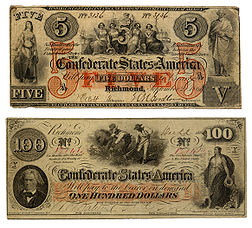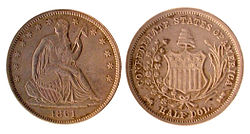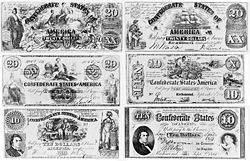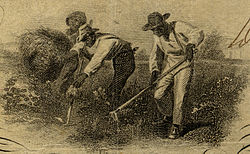- Confederate States of America dollar
-
Confederate States of America dollar 
Front of Confederate notes (back unprinted) User(s)  Confederate States of America
Confederate States of AmericaSubunit 1/100 cent Symbol $ or C$ cent ¢ Coins none Banknotes 10¢, 50¢, $1, $2, $5, $10, $20, $50, $100, $500, $1000 This infobox shows the latest status before this currency was rendered obsolete. The Confederate States of America dollar was first issued into circulation in April 1861, when the Confederacy was only two months old, and on the eve of the outbreak of the Civil War.
At first, Confederate currency was accepted throughout the South as a medium of exchange with high purchasing power. As the war progressed, however, confidence in the ultimate success waned, the amount of paper money increased, and their dates of redemption were extended further into the future. Most Confederate currency carried the phrase across the top of the bill: "TWO YEARS AFTER THE RATIFICATION OF A TREATY OF PEACE BETWEEN THE CONFEDERATE STATES AND THE UNITED STATES OF AMERICA" then across the middle, the "CONFEDERATE STATES OF AMERICA will pay" [the amount of the bill] "to BEARER." As the war progressed, the currency underwent the depreciation and soaring prices characteristic of inflation. For example, by the end of the war, a cake of soap could sell for as much as $50 and an ordinary suit of clothes was $2,700.
Near the end of the war, the currency became practically worthless as a medium of exchange. In no small part this is because Confederate currency was actually not money, but bills of credit, just as was seen in the Revolutionary War, and concomitantly not secured, or backed by any assets. Just as the currency issued by the Continental Congress was deemed worthless (witness the phrase "not worth a Continental;" and see The Federalist Papers, which also addressed this issue in the run-up to the ratification of the U.S. Constitution) because they were not backed by any hard assets, so, too, this became the case with Confederate currency. Even though both gold and silver may have been scarce, some economic historians have suggested that the currency would have retained a relatively material degree of value, and for a longer period of time, had it been backed by hard goods the Confederacy did have, perhaps such as cotton, or tobacco. When the Confederacy ceased to exist as a political entity at the end of the war, the money lost all value as fiat currency.
Contents
Designs
The South, being limited in skilled engravers and printers as well as secure printing facilities, often had to make do with unrelated designs in early banknote issues. Some such were abstract depictions of mythological gods and goddesses. Southern themes did prevail with designs of black slaves, naval ships, and historical figures, including George Washington. Images of slaves often had them depicted as smiling or happily carrying about their work. John Jones has recreated these images as large acrylic paintings in a contemporary series called "Confederate Currency: The Color of Money."
Since most of the engravers and bank plates were in the North, Southern printers had to lift by offset or lithographic process scenes that had been used on whatever notes they had access to. Many variations in plates, printing and papers also appear in most of the issues, due in large part to the limits on commerce resulting from the Union embargo of Confederate ports.
Later note issues pictured notable Southern politicians, military leaders, and citizens. Some Southerners who appeared on CSA currency included Jefferson Davis, Alexander Stephens, Lucy Pickens, George Randolph, R. M. T. Hunter, and Stonewall Jackson.
Signatures
Confederate Treasury Notes were hand signed by various clerks, with exception of the 50 cent issues that had the printed signatures of Robert Tyler and Edward C. Elmore. The first six notes issued were hand signed by the Register and Treasurer themselves. While hand signatures were considered an anti-counterfeiting tool, the sheer number of bills being produced could not reasonably be signed individually by two men each. Women were often hired as clerks to sign "for Register" and "for Treasurer"; up to 200 clerks were eventually hired for each.
Coinage
As the Civil War continued, the cost of the war loomed large. Any precious metals available in the South often made their way to Europe to procure war goods. But the CSA did manage to mint a few coins. In 1861, Mr. Robert Lovett Jr. of Philadelphia was commissioned to design, engrave, and make a one cent piece for the Confederacy. On the obverse (front), he used the head of Minerva (French Liberty Head), which he had used on several store cards. The coins were struck using the then Federal standard of cupronickel for cent pieces. He made a few samples, of which only 12 are said to exist by the popular stories but research has shown that 14 are currently known to exist. Fearing prosecution for aiding the enemy, he stopped his work, and hid the coins and dies in his cellar. The original dies were purchased later and used to make restrikes, first by John W. Haseltine and later by Robert S. Bashlow. The dies were donated to the Smithsonian Institution by Bashlow in 1962.
In late April of 1861, four Confederate half dollars were struck on a hand press by certain employees of the New Orleans Mint. Because of the high relief of the coin die, a test striking was made to see if coins would release from the Confederate die. The die was made by a printing plate engraver (A.H.M. Peterson) in New Orleans who was unfamiliar with techniques required to engrave coining dies. These coins were struck using a U.S. obverse die (Seated Liberty) and the Confederate die made by Peterson. These coins are known as originals, and the location of all four of the coins is known today.
 A Confederate Half Dollar struck at New Orleans in 1861.
A Confederate Half Dollar struck at New Orleans in 1861.
 6 Confederate States of America currency notes three $10 notes 3 $20 notes
6 Confederate States of America currency notes three $10 notes 3 $20 notes
As the result of an 1879 article about the Confederate cent printed in a New York City newspaper, Benjamin F. Taylor, M.D. (Chief Coiner, New Orleans Mint, CSA) contacted coin dealer Ebenezer Mason. Taylor informed Mason of the existence of the Confederate half dollar and the die. Mason bought the die and coin from Taylor and sold them to J.W. Scott Co. of New York City, a coin and stamp dealer. Scott bought 500 1861 United States half dollars from a New York bank that were supposedly struck at the New Orleans Mint. Scott had the reverse of the half dollars planed down and performed a one-sided strike using the Confederate half dollar die. The Seated Liberty obverse of the coins were flattened some because of the one-sided strike. In addition, Scott struck 500 half dollar sized tokens in a white metal using the Confederate die and a newly made die to commemorate the restrikes of the Confederate half dollars. The Confederate half dollar die went missing during the 1920s and has not been seen since.
Popular stories claim one of the Confederate half dollars was given to Confederate President Jefferson Davis. This story has no basis in fact. In an 1879 letter to Ebenezer Mason, Davis confirmed that a Union soldier (actually a Federal Officer) stole a coin from one of his wife’s trunks, but could not confirm that it was like the then known Confederate half dollar. It is very possible that the coin was a gold so-called Jefferson Davis dime struck at the Paris (France) Mint, which Davis described to coin dealer Ed Frossard in an 1880 letter. All known Jefferson Davis dimes were struck in silver at the Paris Mint. The Davis letter is the only known reference to a gold specimen, which was likely a special presentation piece made for Davis.
Banknotes
Confederate Treasury Notes (Banknotes) were ultimately issued in 50-cent, $1, $2, $5, $10, $20, $50, $100, $500, and $1,000 denominations with a variety of designs, issuers and redeemable obligations. The amount of currency issued under the various acts of the Confederate Congress totaled $1.7 billion. Bills were released in 72 different note "types" in seven "series" from 1861 through 1864.
Since there were many types of Confederate notes as well as notes issued by the states of the Confederacy, and since banks could issue their own notes, counterfeiting was a major problem for the Confederacy. Many of these contemporary counterfeits are identifiable today and they can be as valuable to a collector as a real note.
See also
- Economy of the Confederate States of America
- Fourteenth Amendment to the United States Constitution, which banned the Federal recognition of Confederate debts or currency.
- United States currency
- Samuel C. Upham, a notorious counterfeiter of Confederate bills.
References
- Fricke, Pierre. Collecting Confederate Paper Money - Field Edition 2008. ISBN 9780971082151.
- Yeoman, R. S.. A Guide Book of United States Coins. ISBN 0794817904.
- 2005 Blackbook Price Guide to United States Paper Money. ISBN 1400048397.
- Levi, Harold; Corell, George (2006). The Lovett Cent; a Confederate Story. Lulu.com. ISBN 9781847288783.
External links
- Currency issued by States of the Confederacy
- The Story of Confederate Currency
- Collecting Confederate Paper Money
- Professional Grading Service
- Coin Facts
- Rebel States Currency
- Mintmark Numismatics, Inc
- Photos and descriptions of Confederate Currency in McCune Collection
United States currency and coinage Topics Current coinage Bullion coinage America the Beautiful Silver Bullion Coins · American Buffalo · American Gold Eagle · American Platinum Eagle · American Silver EaglePaper money See also Bicentennial coinage · Commemoratives · Early Commemoratives · Modern Commemoratives · Confederate dollar · Fake denominations · Obsolete denominations · Mill · Coin production · In God We Trust · E pluribus unum · NicknamesCategories:- Dollar
- Economic history of the American Civil War
- Historical currencies of the United States
- Economic history of the Confederate States of America
- Modern obsolete currencies
Wikimedia Foundation. 2010.

